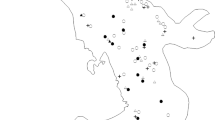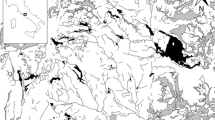Abstract
Although the role of habitat fragmentation in species declines is well recognised, the effect of habitat quality on species distributions is often studied using presence–absence models that ignore metapopulation dynamics. We compared three approaches to model the presence–absence of North Island robins in 400 sites among 74 fragments of native forest in a 15,000-ha agricultural landscape in New Zealand. The first approach only considered local habitat characteristics, the second approach only considered metapopulation factors (patch size and isolation), and the third approach combined these two types of factors. The distribution of North Island robins was best predicted by patch isolation, as their probability of occurrence was negatively correlated with isolation from neighbouring patches and from the closest major forests, which probably acted as a source of immigrants. The inclusion of habitat factors gave only a slight increase in predictive power and indicated that robins were more likely to occur in areas with tall canopy, tall understory and low density of young trees. We modelled the effect of isolation using an index of functional patch connectivity based on dispersal behaviour of radio-tracked juveniles, and this functional index greatly improved the models in comparison to classical indices relying on Euclidean distances. This study highlights the need to incorporate functional indices of isolation in presence–absence models in fragmented landscapes, as species occurrence can otherwise be a misleading predictor of habitat quality and lead to wrong interpretations and management recommendations.


Similar content being viewed by others
References
Anderson AJ (1991) The chronology of colonization in New Zealand. Antiquity 65:767–795
Andren H (1995) Effects of landscape composition on predation rates at habitat edges. In: Hansson L, Fahrig L, Merriam G (eds) Mosaic landscapes and ecological processes. Chapman & Hall, London, UK, pp 225–255
Armstrong DP (2005) Integrating the metapopulation and habitat paradigms for understanding broad-scale declines of species. Conserv Biol 19:1402–1410
Armstrong DP, Raeburn EH, Lewis RM, Ravine D (2006) Modeling vital rates of a reintroduced New Zealand robin population as a function of predator control. J Wildl Manage 70:1028–1036
Bell BD (1986) The conservation status of New Zealand wildlife. New Zealand Wildlife Service, Dept. of Internal Affairs, Wellington, New Zealand
Betts M, Diamond A, Forbes G, Villard M (2006) The importance of spatial autocorrelation, extent and resolution in predicting forest bird occurrence. Ecol Model 191:197–224
Bock CE, Jones ZF (2004) Avian habitat evaluation: should counting birds count? Front Ecol Environ 2:403–410
Boulton RL, Richard Y, Armstrong DP (2008) Influence of food availability, predator density and forest fragmentation on nest survival of New Zealand robins. Biol Conserv 141:580–589
Brown JH, Kodric-Brown A (1977) Turnover rates in insular biogeography: effect of immigration on extinction. Ecology 58:445–449
Burke DM, Nol E (1998) Influence of food abundance, nest-site habitat, and forest fragmentation on breeding ovenbirds. Auk 115:96–104
Burnham KP, Anderson DR (2002) Model selection and multimodel inference: a practical information-theoretic approach. Springer, New York, USA
Carroll C (2006) Linking connectivity to viability: insights from spatially explicit population models of large carnivores. In: Crooks KR, Sanjayan MA (eds) Connectivity conservation. Cambridge University Press, Cambride, UK, pp 369–389
Castellón TD, Sieving KE (2006) Landscape history, fragmentation, and patch occupancy: models for a forest bird with limited dispersal. Ecol Appl 16:2223–2234
Caughley G (1994) Directions in conservation biology. J Anim Ecol 63:215–244
Chalfoun AD, Thompson FR III, Ratnaswamy MJ (2002) Nest predators and fragmentation: a review and meta-analysis. Conserv Biol 16:306–318
Clubb S (2003) Territory choice of reintroduced North Island robins (Petroica australis longipes) in a predator controlled forest reserve in New Zealand. M.Sc. thesis, Napier University, Edinburgh, Scotland
Cohen J (1960) A coefficient of agreement for nominal scales. Educ Psychol Meas 20:37–46
Connor EF, Courtney AC, Yoder JM (2000) Individuals-area relationships: the relationship between animal population density and area. Ecology 81:734–748
Cowley MJR, Wilson RJ, Leon-Cortes JL, Gutierrez D, Bulman CR, Thomas CD (2000) Habitat-based statistical models for predicting the spatial distribution of butterflies and day-flying moths in a fragmented landscape. J Appl Ecol 37:60–72
Didham RK, Barker GM, Costall JA, Denmead LH, Floyd CG, Watts CH (2009) The interactive effects of livestock exclusion and mammalian pest control on the restoration of invertebrate communities in small forest remnants. N Z J Zool 36:135–163
Doak P (2000) The effects of plant dispersion and prey density on parasitism rates in a naturally patchy habitat. Oecologia 122:556–567
Doebeli M, Ruxton GD (1998) Stabilization through spatial pattern formation in metapopulations with long-range dispersal. Proc R Soc Lond Biol Sci 265:1325–1332
Ewers RM, Kliskey AD, Walker S, Rutledge D, Harding JS, Didham RK (2006) Past and future trajectories of forest loss in New Zealand. Biol Conserv 133:312–325
Farina A (1998) Principles and methods in landscape ecology. Chapman & Hall, London, UK
Fielding AH, Bell JF (1997) A review of methods for the assessment of prediction errors in conservation presence/absence models. Environ Conserv 24:38–49
Fleishman E, Mac Nally R, Fay JP (2003) Validation tests of predictive models of butterfly occurrence based on environmental variables. Conserv Biol 17:806–817
Gobeil J-F, Villard M-A (2002) Permeability of three boreal forest landscape types to bird movements as determined from experimental translocations. Oikos 98:447–458
Goodwin BJ, Fahrig L (2002) How does landscape structure influence landscape connectivity? Oikos 99:552–570
Guisan A, Zimmermann NE (2000) Predictive habitat distribution models in ecology. Ecol Model 135:147–186
Gustafson EJ, Parker GR (1994) Using an index of habitat patch proximity for landscape design. Landsc Urban Plann 29:117–130
Hanski I (1998) Metapopulation dynamics. Nature 396:41–49
Hanski I, Gaggiotti OE (2004) Metapopulation biology: past, present, and future. In: Hanski I, Gaggiotti OE (eds) Ecology genetics and evolution of metapopulations: standard methods for inventory and monitoring. Elsevier, London, UK, pp 3–22
Hanski I, Alho J, Moilanen A (2000) Estimating the parameters of survival and migration of individuals in metapopulations. Ecology 81:239–251
Harrell FE (2001) Regression modelling strategies: with application to linear models, logistic regression, and survival analysis. Springer, New York, USA
Harrison S, Bruna E (1999) Habitat fragmentation and large-scale conservation: what do we know for sure? Ecography 22:225–232
Haynes KJ, Cronin JT (2006) Interpatch movement and edge effects: the role of behavioral responses to the landscape matrix. Oikos 113:43–54
Heather BD, Robertson HA (2000) The field guide to the birds of New Zealand. Viking, Auckland, New Zealand
Helzer CJ, Jelinski DE (1999) The relative importance of patch area and perimeter-area ratio to grassland breeding birds. Ecol Appl 9:1448–1458
Higgins PJ, Peter JM (2002) Petroica australis, New Zealand robin. In: Higgins PJ, Peter JM (eds) Handbook of Australian, New Zealand, and Antarctic Birds. Vol. 6: Pardalotes to Shrike-Thrushes. Oxford University Press, Melbourne, Australia, pp 706–725
Holdaway RN (1999) Introduced predators and avifaunal extinction in New Zealand. In: McPhee RD (ed) Extinctions in near time. Kluwer Academic/Plenum, New York, USA, pp 189–238
Hosmer DW, Lemeshow S (2000) Applied logistic regression, 2nd edn. Wiley, New York, USA
Keitt TH, Bjørnstad ON, Dixon PM, Citron-Pousty S (2002) Accounting for spatial pattern when modeling organism-environment interactions. Ecography 25:616–625
Klute DS, Lovallo MJ, Tzilkowski WM (2002) Autologistic regression modeling of American woodcock habitat use with spatially dependent data. In: Scott JM, Heglund PJ, Morrison ML, Haufler JB, Raphael MG, Wall WA, Samson FB (eds) Predicting species occurrences. Island Press, Washington, DC, pp 335–343
Landis JR, Koch GC (1977) The measurement of observer agreement for categorical data. Biometrics 33:159–174
Lawton JH, Woodroffe GL (1991) Habitat and the distribution of water voles: why are there gaps in species range? J Anim Ecol 60:79–91
Leathwick JR, Wilson G, Rutledge D, Wardle P, Morgan F, Johnston K, McLeod M, Kirkpatrick R (2003) Land environments of New Zealand. Auckland, New Zealand
Legendre P (1993) Spatial autocorrelation: problem or new paradigm? Ecology 74:1659–1673
Lichstein JW, Simons TR, Shriner SA, Franzreb KE (2002) Spatial autocorrelation and autoregressive models in ecology. Ecol Monogr 72:445–463
MacArthur RH, Wilson EO (1967) The theory of island biogeography. Princeton University Press, Princeton, New Jersey, USA
Manel S, Dias JM, Ormerod SJ (1999) Comparing discriminant analysis, neural networks and logistic regression for predicting species distributions: a case study with a Himalayan river bird. Ecol Model 120:337–347
Moilanen A, Hanski I (1998) Metapopulation dynamics: effects of habitat quality and landscape structure. Ecology 79:2503–2515
Ozesmi SL, Ozesmi U (1999) An artificial neural network approach to spatial habitat modelling with interspecific interaction. Ecol Model 116:15–31
Paton PWC (1994) The effect of edge on avian nest success: how strong is the evidence? Conserv Biol 8:17–26
Potter MA (1990) Movement of North Island Brown Kiwi (Apteryx australis mantelli) between forest remnants. N Z J Ecol 14:17–24
Pulliam HR (1988) Sources, sinks, and population regulation. Am Nat 132:652–661
Reed DH (2004) Extinction risk in fragmented habitats. Anim Conserv 7:181–191
Ribeiro PJ Jr, Diggle PJ (2001) geoR: a package for geostatistical analysis. R-NEWS 1:15–18
Richard Y (2007) Demography and distribution of the North Island robin (Petroica longipes) in a fragmented agricultural landscape of New Zealand. Ph.D. thesis, Massey University, Palmerston North, New Zealand
Richard Y, Armstrong DP (2010) Cost distance modelling of landscape connectivity and gap-crossing ability using radio-tracking data. J Appl Ecol 47:603–610
Ricketts TH (2001) The matrix matters: effective isolation in fragmented landscapes. Am Nat 158:87–99
Robertson CJR, Hyvönen P, Fraser MJ, Pickard CR (2007) Atlas of bird distribution in New Zealand, 1999–2004. The Ornithological Society of New Zealand, Inc., Wellington, New Zealand
Rushton SP, Barreto GW, Cormack RM, Macdonald DW, Fuller R (2000) Modelling the effects of mink and habitat fragmentation on the water vole. J Appl Ecol 37:475–490
Saunders DA, Hobbs RJ, Margules CR (1991) Biological consequences of ecosystem fragmentation: a review. Conserv Biol 5:18–32
Sih A, Jonsson BG, Luikart G (2000) Habitat loss: ecological, evolutionary and genetic consequences. Trends Ecol Evol 15:132–134
Simberloff D, Farr JA, Cox J, Mehlman DW (1992) Movement corridors: conservation bargains or poor investments? Conserv Biol 6:493–504
Smart SM, Firbank LG, Bunce RGH, Watkins JW (2000) Quantifying changes in abundance of food plants for butterfly larvae and farmland birds. J Appl Ecol 37:398–414
R Development Core Team (2006) R: A language and environment for statistical computing. R Foundation for Statistical Computing, Vienna, Austria. URL: http://www.R-project.org
Van Horne B (1983) Density as a misleading indicator of habitat quality. J Wildl Manage 47:893–901
Van Teeffelen AJA, Cabeza M, Moilanen A (2006) Connectivity, probabilities and persistence: comparing reserve selection strategies. Biodivers Conserv 15:899–919
Vitousek PM, Mooney HA, Lubchenco J, Melillo JM (1997) Human domination of Earth’s ecosystems. Science 277:494–499
Whittingham MJ, Krebs JR, Swetnam RD, Vickery JA, Wilson JD, Freckleton RP (2007) Should conservation strategies consider spatial generality? Farmland birds show regional not national patterns of habitat association. Ecol Lett 10:25–35
Winfree R, Dushoff J, Crone EE, Schultz CB, Budny RV, Williams NM, Kremen C (2005) Testing simple indices of habitat proximity. Am Nat 165:707–717
Wintle BA, Bardos DC (2006) Modeling species-habitat relationships with spatially autocorrelated observation data. Ecol Appl 16:1945–1958
Acknowledgements
We are grateful to Robyn Peacocke as well as to the Tiroa and Te Hape B Trusts for permission to work on their land, Robert Gibb (Landcare Research Ltd.) for his help with GIS, Thibaud Porphyre, Mike Joy, Chris Wilcox, Brendan Wintle, Hugh Possingham and Rebecca Boulton for their assistance in various stages of the analysis and writing. We also thank three anonymous referees for their comments on the manuscript. This project was funded by grants MAU 003 and MAU 0404 from the Marsden fund of the Royal Society of New Zealand.
Author information
Authors and Affiliations
Corresponding author
Electronic supplementary material
Below is the link to the electronic supplementary material.
Rights and permissions
About this article
Cite this article
Richard, Y., Armstrong, D.P. The importance of integrating landscape ecology in habitat models: isolation-driven occurrence of north island robins in a fragmented landscape. Landscape Ecol 25, 1363–1374 (2010). https://doi.org/10.1007/s10980-010-9488-8
Received:
Accepted:
Published:
Issue Date:
DOI: https://doi.org/10.1007/s10980-010-9488-8




